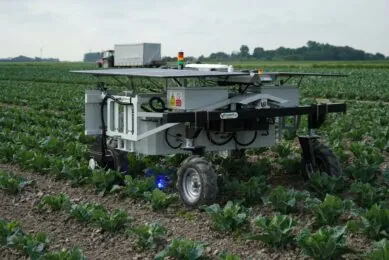Lemken and Krone aim for large-scale perfection with field robots

At the end of May, Krone and Lemken showed two autonomous vehicles to the European press. The robots are particularly large. They will be commercially available in three years’ time. An impression.
When we enter the field in Hopsten, Germany, to see the robots, the first impression is that they are particularly large. The autonomous vehicles look small in photographs, but someone with a height of 2 metres cannot see over them. Krone and Lemken call this robot the “VTE field robot”, where VTE stands for “Verfahrenstechnischen Einheit”, which can be translated into “Process engineering unit”.
230 hp
The field robot has an MTU four-cylinder engine that delivers 230 hp to a generator and has a fuel tank of 260 litres. This provides power to both axles and the power take-off. The robot weighs almost 8 tonnes and is fitted with four 650/65 R38 Trelleborg IF tyres.
The manufacturers indicate that the diesel engine can be replaced by a battery pack or hydrogen fuel cell in the future.
The robot has a maximum speed of 20 km/h and is equipped with four-wheel drive, four-wheel steering and crab steering. Because the vehicle was developed to drive only on fields, it is not equipped with an air pressure exchange system. According to the manufacturer, transport by road will be done for the time being with a low-loader.
Text continues below image

Sensors and stereo cameras
The field robot has several sensors that monitor the work process and stereo cameras that keep a close eye on the surroundings. “We have Lidar sensors on the field robot that can measure the distance and recognise obstacles,” explains Jan Horstmann (development director at Krone). Is it an obstacle that the field robot needs to react to or not? In autonomous operations, you want to check that the implement is working properly.
Each individual implement will be equipped with sensors which will be needed for that particular implement. A mower for instance will be equipped with about 20 to 30 sensors. The sensors measure many different functions and keep a close eye on the machine (think of blockages, or mower blades that are broken or lost). The robot must respond immediately and stop.
The sensors measure everything that has to do with the quality of the work that is being done. It must be perfect. If there is a malfunction, the operator is informed via a message on his smartphone and has to react to it.
Text continues below image

TIM as a basis
The Tractor Implement Management system (TIM), in which the implement sends commands about e.g. hydraulic functions, driving speed, PTO to the tractor, has been available for trailed implements since 2011. However, according to Krone and Lemken, no tractor manufacturer has yet implemented this system. Tractor manufacturers do not focus on optimal steering and perfect control and execution of the work process. Krone and Lemken do. They believe that the quality of the work done by a trailed implement must be perfect everywhere.
Real-time tracking with Telemetry System
The vehicles are equipped with a Telemetrics system so they can be monitored in real time. An electronic device (laptop, smartphone, tablet) can be used to send data such as the issuing of a new task (mowing, raking, tedding, cultivating, ploughing or sowing) to the robot.
In addition, data about the work process such as driving speed, the area of land already worked or still to be processed, working width, the field name can be read. Information about the robot and working conditions such as fuel consumption, ambient temperature and wind speed is also available.
Text continues below image

Five models ready in 2023
Lemken and Krone expect to have five models ready in 2023 and to be able to enter the market in 2025. In the coming period, the sensors will be observed very closely. The expected production number is not yet known. A fulle equipped cabin on the robot was not considered necessary by the developers. The expected price is about € 230,000.
The reason why Lemken and Krone started this project seven years ago is mainly related to the (worldwide) problems that many farmers are facing: lack of time, shortage of skilled personnel, repetitive work and increasing complexity of machinery.
According to the manufacturers, an autonomous driving vehicle can be the solution, with a field robot that can deliver the same quality anywhere and anytime. This depends on the ability of the machine to adapt itself to all circumstances. Therefore, the functions of the autonomous vehicle must be continuously monitored and the settings of the trailed implements must be recorded. The communication systems Agrirouter, Isobus and TIM must ensure that work is done not harder but smarter.
Join 17,000+ subscribers
Subscribe to our newsletter to stay updated about all the need-to-know content in the agricultural sector, two times a week.



